
How to Maintain Your Lawn Mower – A Complete Guide
Before firing up your new mower, knowing how to maintain it is key, especially in tough climates. There's nothing more frustrating than your mower conking out half way through your lawn on a scorching summer day. Mowing the lawn always sounds like a good idea until your mower is coughing and spluttering like it's had too many passionfruit vapes.
The Aussie climate doesn’t do mowers any favours. Extreme heat makes them overheat, and your clogged air filter won’t help in cold conditions. Keeping your mower in check means fewer repairs, more free time, and no more battles with knee-high grass. In this article, I'll break it down for every mower—whether it's a manual push reel, petrol, ride-on, electric, or battery-powered.
How to Maintain Specific Types of Lawn Mowers
Whether you’re pushing a manual reel mower, a battery-powered model or revving up a petrol machine, each type has its own maintenance routines. Here, I'll break it all down:
1. Manual Push Reel Mowers
Manual push reel mowers are as basic as it gets. No engine, no fuel—just pure elbow grease! But, to keep them slicing through the grass, you have to sharpen the blades regularly.
Grab a sharpening kit or sandpaper and grind against the blades. While there's no hard and fast rule on when to sharpen the reels, I do this after every 10 to 20 hours of use. It's also great to check the bed knife and cutting edges to see if they're nicked, bent, or dull before every mowing session.

Source: https://lawnsolutionsaustralia.com.au/lawn-care/lawn-mowing/how-to-back-lap-a-cylinder-mower/
If you skip these maintenance routines, you’ll end up pushing harder than necessary. It’s also a leading cause of yellowing lawns. When the mowing blades or cartridges aren't sharp, grass blades get torn off quite aggressively. They take several days to heal and green up again.
Next, don’t forget to lube up the moving parts. These include the wheel bearings, the roller bearings, reel axle, t hrottle cable, height adjuster, handle pivot points, and crank or gearbox. A bit of oil here and there keeps everything rolling smoothly.
Notes on Lubrication
I recommend food-grade silicone spray such as WD-40 Specialist Silicone Lubricant. But, by all means, avoid using heavy oils, lubes containing Teflon or greases with abrasive particles (e.g., graphite, molybdenum disulphide). They can attract dirt and dust.
2. Petrol Lawn Mowers
Petrol mowers are the workhorses of the mowing world. They are tough and powerful and will tackle thick grass, steep slopes, and large yards. But, to keep them running smoothly, regular maintenance is a must. Here are some key components to check and maintain:
Spark Plug
First, check the spark plug at the beginning of each mowing season or after a prolonged period of unuse. If it’s black, gunky, or rusty, it’s time for a replacement.
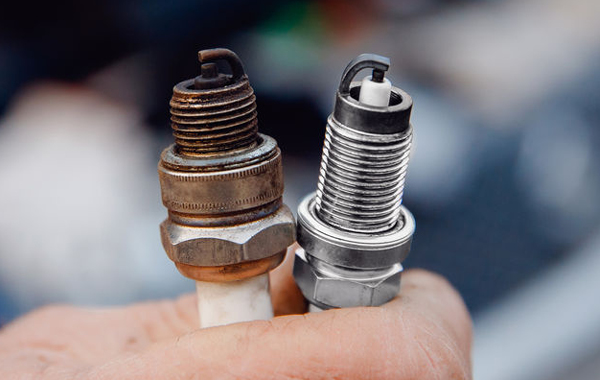
Source: https://jiffylubespecials.com/blog/how-do-you-know-if-your-spark-plugs-need-to-be-changed
An old, carbon-filled spark plug can make starting your mower feel like wrestling with a kangaroo. But when you swap it out, you'll notice a big difference during startup and general performance.
Carburettor
The carburettor is next. What it does is draw air into the engine in the correct ratio, while atomizing fuel into a fine spray. If this little part gets clogged with dirt or water, it doesn't perform its function and your mower’s going nowhere. You’ll be pulling that cord until your arm goes numb.
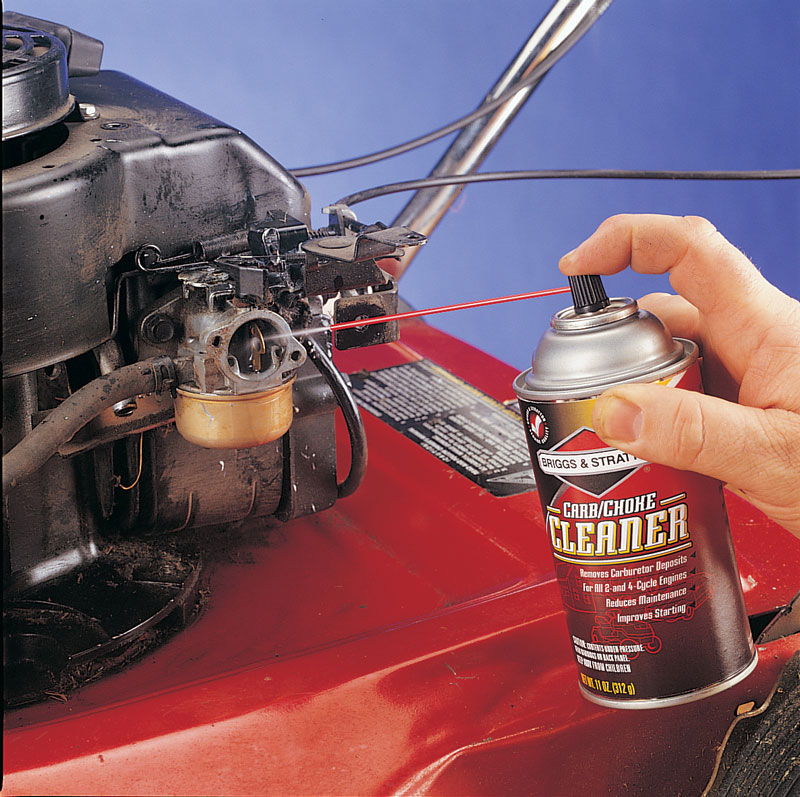
Fuel and Storage Tips
If you’re storing your mower for a while (like over winter), don’t leave fuel in the tank. Petrol goes stale and can gunk up the engine. If you’ve got leftover petrol, add a fuel stabiliser before storing it. It’ll keep the fuel fresh for as long as 24 months and stop the carburettor from clogging.
Oil Changes
One more thing, don’t forget about oil changes. Just like your car, your petrol mower needs fresh oil to keep moving parts working smoothly, reduce friction, cool, take away dirts and prevent rust in the engine. I change mine at least once a season. Dirty or insufficient oil can damage the engine over time, and trust me, fixing that is way more expensive than a simple oil change.
How to Fix or Replace Your Pull Cords
Snapped or retracted pull cords are a common problem for petrol mowers. You’ll just need a new cord (if it's snapped) and a screwdriver.
To fix it, remove the recoil cover, check the springs, manually rewind it back to the housing, and reassemble it carefully.

Source: https://sgtknots.com/blogs/news/how-to-replace-small-engine-pull-cord-on-mower
If the cord is frayed, damaged, or it's snapped, get a new recoil cord and follow the steps in your manual, or check out a quick video tutorial online. If you're not sure of your repair or DIY skills, call a repairman.
3. Ride-On Mowers (Lawn Tractors)
Now, if you cruise around the lawn on a ride-on mower like the G-Force 432CC (or looking to get one), you’re living the dream. But, like all good things, it needs some care to keep running smoothly.
Engine and Belts
First up is the engine. Treat it like you would your car. Regular oil changes are a must. For a ride-on lawnmower like the G-Force model, the recommended oil type is a 4-Stroke, High-Detox (HD) or Premium quality oil with 10W-30 or 10W-40 viscosity. 10W-40 or 15W-40 oil works for hot climates, while 5W-30 or 0W-30 is fine for colder seasons.
Check the oil before each use, and change it at least once a season. And while you’re at it, give the belts a quick look. Your ride-on mower typically has two main belts: the drive and the deck belt. While the drive belt connects the engine to the transmission, ensuring your mower moves, the deck belt connects the engine to the mower deck, spinning the blades so you can cut the grass.
Replace the belts immediately before they snap if they are worn or cracked. A busted belt mid-mow is no fun. Here's how to replace a ride-on mower's belt:
Step 1. Before anything else, turn off your mower. Then, disconnect the spark plug.
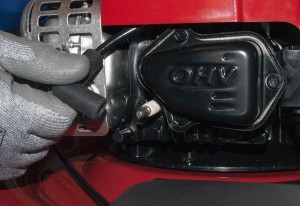
Source: https://www.searspartsdirect.com/diy/repair-guide/how-to-replace-a-lawn-mower-drive-belt
Step 2. If it’s the deck belt you're replacing, lower the mower's body. If it's a drive belt issue, locate the drive system under the mower's deck.
Step 3. Pick up your mower manual and use it to trace the belt path. Figure out how it loops around the pulleys. Now, carefully remove the old belt, grab the new belt and follow the same path as the old one. Make sure it’s snug in the pulleys.
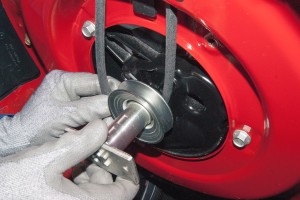
Source: https://www.searspartsdirect.com/diy/repair-guide/how-to-replace-a-lawn-mower-drive-belt
Step 4. Having done that, reconnect the spark plug, fire up the mower, and give it a quick test run.
Tyre Pressure and Worn Tyres
Next, let’s talk about tyres. You wouldn’t drive your car on flat tyres, right? The same goes for your mower. Low tyre pressure can mess with the cutting height and make steering a nightmare. Check the tyre pressure regularly (once every 5-10 hours of operation) with a Digital Tire Pressure Gauge and top them up as needed.
Typically, your ride-on mower front tyres require 8-12 PSI (0.55-0.83 bar), while the rear tyres need 10-15 PSI (0.69-1.03 bar). If the treads are worn, it’s time for new tyres.
Cutting Deck and Blades
Now, let’s get under the hood—or rather, the deck. The deck is where the cutting happens. So to get good results, make sure you keep it clean! Grass buildup can affect the airflow and leave your lawn looking patchy.
Scrape off any gunk from the deck after each use. And don’t forget about the blades. Dull blades tear the grass, leaving it more vulnerable to disease. Sharpen them up every season or when you notice the cut isn’t clean. Ideally, you should replace your mower blades once annually - although some can last a few years.
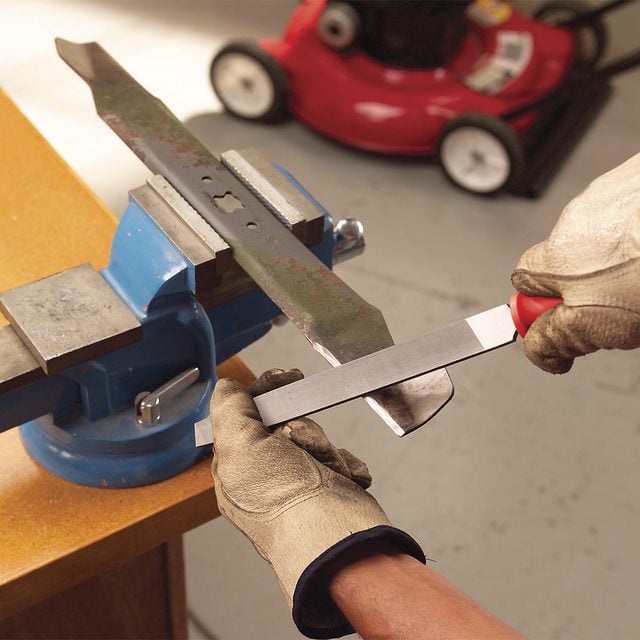
Source: https://www.familyhandyman.com/project/lawn-mower-blade-sharpening/
Bonus Tip: Cleaning and Storage
After each mow, give the ride-on a quick clean. Remove grass clippings, especially around the deck and engine. And when the mowing season’s over, store it in a dry spot. Add some fuel stabilizer if there's leftover petrol. Then cover it up to protect it from dust and moisture. This way, your mower’s ready to roll come spring.
4. Battery Mowers
Battery mowers like the G-Force 60V Brushless Lawn Mower are the eco-friendly champs of the mowing world. They're quiet, efficient, and easy to use. But don’t think you can just use, charge them and forget about them. Here’s how to maintain your battery mowers and keep them in top shape during and out of season.
Charging the Battery
First things first, always use the charger that came with your mower. It’s designed for that specific battery. Avoid overcharging for a longer battery life, and never flatten the battery before recharging.
Check the charge level before you mow; there is nothing worse than running out of juice halfway through the lawn. That is probably why you should also get a spare mower battery and keep it charged.
Cleaning and Maintenance
After mowing, wipe down the mower. Grass clippings can build up and block vents. A quick brush-off will keep it tidy. Every few weeks, check the battery contacts for dirt.
A little clean-up here also goes a long way in ensuring no corrosion or dirt buildup.
Warning ⚠️
You must clean a battery mower with care. Water and electricity don’t mix. So, avoid soaking the motor and battery compartments. Instead, use a damp cloth to wipe down the main body.
If you’re hosing off the underside, make sure the battery is out and the mower is switched off. Avoid using high-pressure water, as it can push moisture into the electrical parts.
Storage Tips
When it comes to storing, keep your mower in a cool, dry place. Extreme heat can damage the battery. If you're not using it for a while, charge it up to about 50% before storing it. This keeps the battery healthy and ready for action when you need it. Storing a fully-charged mower is a bad practice and can reduce the battery lifespan.
5. Corded Electric Mowers
Corded electric mowers are a solid choice for small to medium yards. They’re lightweight and as powerful as a petrol mower, if not more. While they're pretty uncommon due to the wire limitations, the big advantage is they are plug-and-use. Plus, they emit less noise, and there are no petrol smells or carbon emissions! Now here's how to maintain an electric mower:
Check the Cord
If you’ve got a corded electric mower with no battery for power, keep an eye on the power cord. Look for any nicks or cuts. A damaged cord can be dangerous and will ruin your mowing session. If you see any issues, replace it before mowing.
Blades and Deck Maintenance
Just like with battery mowers, clean the cutting deck after each use. Grass and debris can clog it up. You should also keep the blades sharpened too. I can't emphasise it enough. Sharp blades make clean cuts and promote healthier grass.
Storage and Weather Prep
Store your electric mower indoors. Avoid leaving it outside in the rain or harsh sun. A little protection goes a long way. Neatly coil the wires to prevent tangles.
Cylinder and Rotary Mowers: The Difference in Maintenance
When it comes to mowing, cylinder and rotary mowers each have their quirks. Next, I'll break down the maintenance differences between these two types, so you'll be able to pick the right approach for your mower or find the best one to buy in case you're simply doing pre-purchase research.
|
Maintenance Task |
Cylinder Mowers |
Rotary Mowers |
|
Blade Sharpness |
Needs frequent sharpening. |
Sharpen less often, but still important. |
|
Cutting Height |
Adjust manually; height stays fixed. |
Adjustable height; simple to tweak. |
|
Cleaning |
Clean under the hood after each use. |
Clear clippings, especially around blades. |
|
Lubrication |
Lubricate moving parts regularly. |
Check and lube pivot points occasionally. |
|
Storage |
Store in a dry spot, blades up. |
Store upright; keep blades off ground. |
|
Fuel and Oil Check |
N/A for manual; petrol cylinder mowers need regular fuel and oil checks |
Regularly check oil and fuel levels. |
Blade Maintenance
Cylinder mowers have multiple (or more) blades. So, they need sharpening often— every 10 to 20 uses. Dull blades tear the grass, not cut it.
On the other hand, rotary mowers don’t need sharpening as frequently. Every 20 to 30 uses is usually fine. Just make sure you check them regularly. If your mower sounds like it’s struggling, it’s time for a tune-up.
Cleaning
Cylinder mowers can trap grass clippings easily. A quick clean after each use prevents build-up.
Like cylinder mowers, rotary ones need a clean, too, but not as frequently as there are less blades to clean. Be sure to clear clippings from the deck, especially around the blades.
Air filter Cleaning or Replacement: Why It’s Necessary and How Often
Your lawn mower does some serious work, and the air filter is basically the unsung hero. Without maintaining the air filter (or without it at all), dust, dirt, and grass clippings would clog the engine quickly. Then you would have to buy a new engine or mower probably every season. Not just that…
A dirty air filter makes your mower work harder. That means more fuel, less power, and maybe even an early trip to the mechanic.

Source: https://lawn.com.au/how-to-clean-a-lawn-mower-air-filter/
How to Clean a Mower's Air Filter
So, by now, you probably understand why you should care. But don’t worry, cleaning or replacing the filter is dead simple. Here’s what you need to do:
Step 1. Check it regularly – Pop it open after every 25 hours of mowing or once a season. The location varies depending on the type. Common locations include behind the engine cover, in the side panel (e.g., Briggs & Stratton, Craftsman), under the handlebar (e.g., some electric mowers), the seat or the operator platform. Once you find it and it’s looking like the outback in a dust storm, it's time to act.
Step 2. Give it a clean – If the air filter is reusable, a quick brush-off or wash will do the trick. Just let it dry completely before you pop it back in.
Step 3. Replace it when needed – If it’s looking beyond saving, just replace it. New air filters are cheap insurance for your mower’s life.
DIY/Cost-Effective Lawn Mower Maintenance Solutions
Keeping your lawn mower in good shape doesn’t have to cost you a fortune. In fact, you can save a heap by doing some basic maintenance yourself. Let’s compare the costs of DIY versus hiring a pro.
Take spark plugs, for example. If you pay someone to replace them, you're looking at around $50 to $80. But if you do it yourself? You can get a spark plug for $10 at your local Supercheap Auto and change it in 10 minutes.
The same goes for blade sharpening. A professional might charge $30 to $50, but with a sharpening file (about $15), you can do it yourself and keep your blades slicing like they're new.
Now, if you're not sure where to start, go get a lawn mower maintenance service kit. These kits usually include an air filter, spark plug, oil, and sometimes even a sharpening tool. Everything you need in one place. You can find them at hardware stores or online for about $15 to $50, depending on your mower model.
For affordable parts and tools, always check local stores, but don’t forget about online shops like eBay or Amazon. Sometimes, you’ll find bargains that beat even the big green shed. And remember, second-hand stores and garage sales are there if you need cheap tools and parts!
Common Maintenance Mistakes and How to Avoid Them
1. Overlooking Oil Changes
Your mower's oil gauge is telling you it's time for an oil top-up or replacement, but you think you can skip that oil change. Think again! Old, dirty oil makes your mower’s engine work harder and can even cause it to overheat.
Eventually, it just stops if your mower has an automatic shutdown feature. If not, it's time to start shopping for a new mower. So, always aim to change your mower’s oil every 50 hours of use or at least once a season. It’s a small job that’ll save you big headaches (and big bucks) down the line.
2. Ignoring Air Filters
The air filter is like your mower’s lungs. If it's clogged up with dirt and grass clippings, your mower has to work twice as hard. A dirty filter means less power, more fuel consumption, and a cranky engine. To avoid this, clean or replace the air filter after every 25 hours of use. Your mower will breathe easy—and so will you.
3. Forgetting to Sharpen Blades
Dull blades don’t just hack away at your grass—they tear it. This leaves your lawn looking patchy, discoloured and stressed.
Worse still, it makes your mower work overtime. Sharpen your blades at least once a season or whenever you notice it struggling to cut. Your lawn will thank you for the clean, smooth trim.
4. Using Incorrect Fuel
Using the wrong fuel is like feeding your Blue Heeler chocolate—bad news. Petrol mowers need unleaded fuel, and some require premium. For electric models, follow the manufacturer’s recommendations closely.
Using the wrong fuel can cause misfiring, engine damage, and costly repairs. A lot of engine owners are carefree with fuel with ethanol but there's a limit to what your engine can take. Most mowers can handle fuel with up to 10% ethanol, also known as E10. Anything higher, from 15% (E15), is not recommended especially in small petrol lawn mowers.
Ethanol can attract moisture, which isn’t great for small engines. Over time, it can lead to rust, corrosion, or even damage your carburetor. So, to put it simply, stick with low-ethanol or ethanol-free fuel when you can. Better still, always check the manual and stick to the right juice.
Common Lawnmower Issues and Troubleshooting Tips
Having lawn mower troubles? Here are a few of the most common lawnmower issues and how to troubleshoot them.
- Mower not starting: It’s likely the spark plug, fuel (petrol, oil), or air filter. Check all three and replace them if needed. A stuck pull cord could mean a damaged cord or spring. Fixing the mower pull cord or spring is a simple repair and can save you a trip to the shop.
-
Lawnmower smoking: Don’t panic. White smoke in a mower doesn’t always spell disaster like it does for cars with a cracked head gasket. But for mowers, it usually means there’s too much oil, or the oil filter is clogged. First, check the oil level. If it’s too high, drain some out. Next, give the air filter a quick look. If it’s dirty, clean it or swap it for a new one. If you’re seeing black smoke, it’s probably a clogged air filter. A quick clean or replacement should sort it out.
 Source: https://lawn.com.au/white-smoke-from-lawn-mower/
Source: https://lawn.com.au/white-smoke-from-lawn-mower/
- Mower oil leaking: This could mean the oil seal is worn out or you’ve overfilled the tank. Either way, fix that oil leak before it causes engine damage since the oil can deplete quite quick should you continue using the mower.
- Water in petrol: Yep, that’ll cause your mower to sputter or stop completely. The engine may find it hard to maintain consistent acceleration. Drain the fuel tank, separate petrol from water, blow out the carburettor, and refill the tank with fresh petrol.
- Tyre off the rim: Use a pry bar to slip it back on or take it to a local tyre shop.
- Mower burning oil: If your mower is burning oil while emitting white smoke, this might be due to worn piston rings. Not ideal, but it's something a mechanic can fix.
- Mower surging: If your mower is surging, don’t jump to conclusions just yet. This is likely a fuel or carburettor issue. A clogged carb can mess with the fuel flow, causing that annoying surge. Clean it out, and you should be back in business. Basically, always start with the basics: fuel first, then check the carb.
If all else fails, check out our recommended service centres to fix your mower!
Seasonal Maintenance Checklists
Here’s a simple list of things to keep your mower in top shape year-round:
Winter Storage Tips
- Drain the fuel or add a fuel stabiliser.
- Clean the mower, removing grass clippings and dirt.
- Cover it up with a winter cover to protect it from dust and moisture.
- Store in a dry place, out of the elements.
Spring Preparation
- Check and change the oil.
- Inspect the air filter and replace if dirty.
- Sharpen or replace the mower blades.
- Clean the mower deck and remove any leftover debris.
- Check the spark plug and replace if needed.
Battery-Powered Mower Tips
- Fully charge the battery before storing.
- Store the battery in a cool, dry place (avoid extreme temperatures).
- Check battery health in spring before first use.
FAQs
1. What's the easiest mower to maintain?
Electric mowers with batteries are quite easy to maintain. They offer the best balance between ease of use and efficiency. Aside from the regular charging which is seamless, there are no engines to fuel, nor are the air filter typically as dirty as the smoke-emitting petrol mowers. To maintain the battery contact after each use, simply disconnect the battery to avoid any accidental starts. Then, grab a plastic scraper to clear any buildup from the underside. Finally, give it a wipe down and let it dry before storing.
2. How often does a lawn mower need oil?
You should change it after every 50 hours of use or at least once per mowing season. Regardless, check the oil level regularly, especially if you’re mowing a lot. Top it up if it's out of gauge and replace the oil once every mowing season.
3. How often should a lawn mower be serviced?
It's best to have your mower serviced once a year, usually in early spring before the mowing season kicks off. This includes checking the spark plug, blades, air filter, and oil.
4. How can I make my lawn mower last longer?
Keep it clean, change the oil regularly, clean the air filter and sharpen the blades regularly. Store it properly during the off-season and avoid mowing over rocks or sticks. Also, regular servicing keeps things in check.
Conclusion
Keeping your lawn mower in top shape isn’t rocket science. From cleaning filters to sharpening blades and charging batteries, we've covered how to maintain everything—from a simple push reel mower to a big lawn tractor. If you’re a proud lawn owner, you know an easy-to-maintain mower is worth its weight in gold. Why spend all your time mowing and fixing your mower? A little upkeep goes a long way. I've also dropped some tips for pure DIYers who want to save some cash while keeping the lawn and mower smooth for years.

